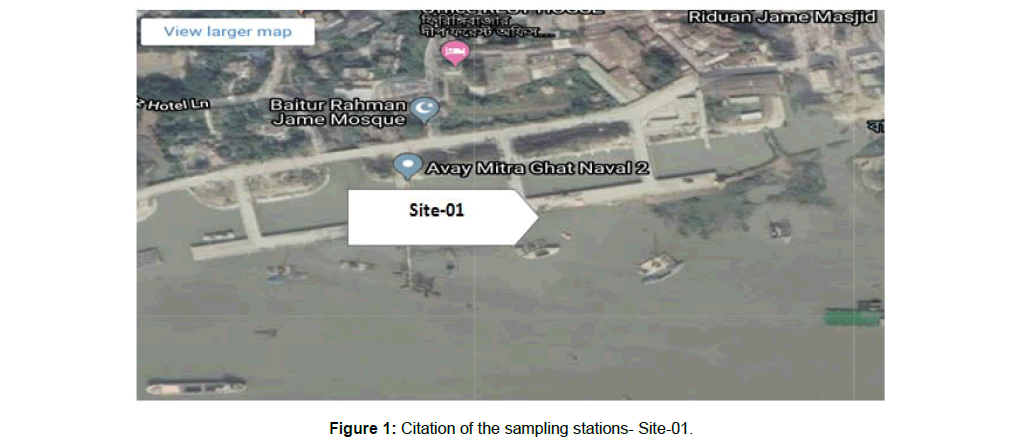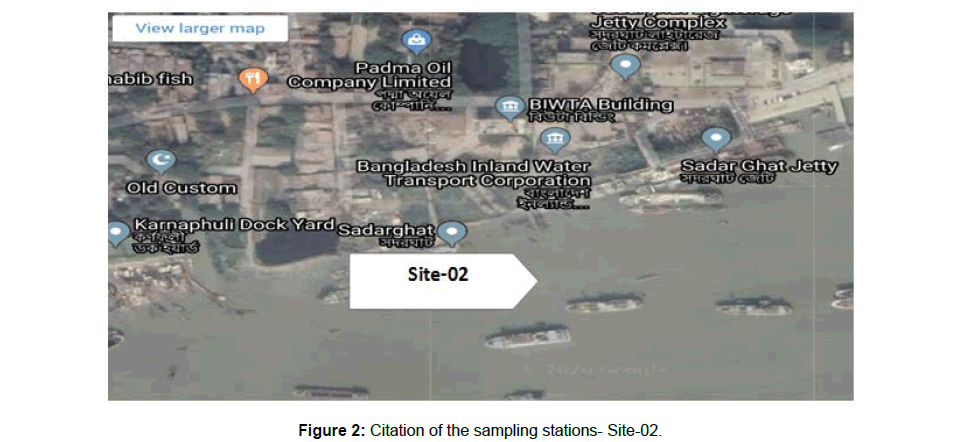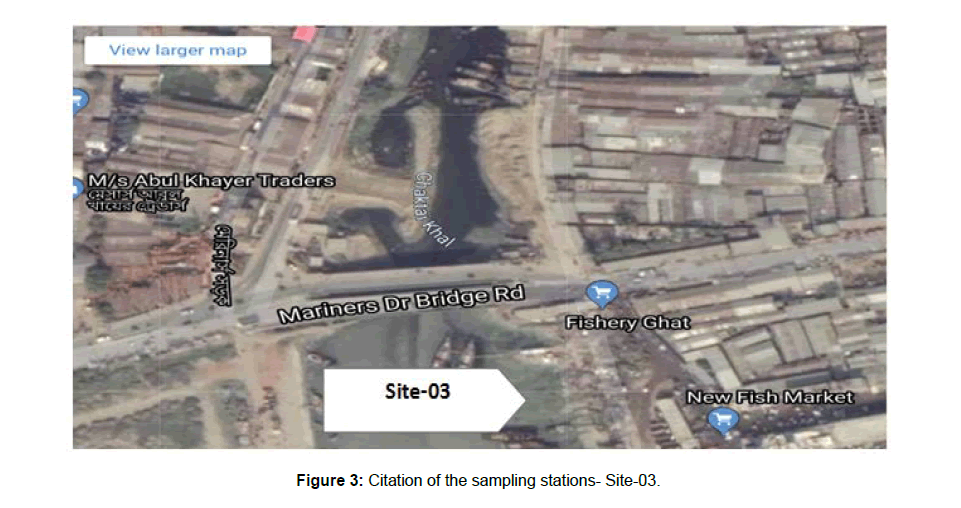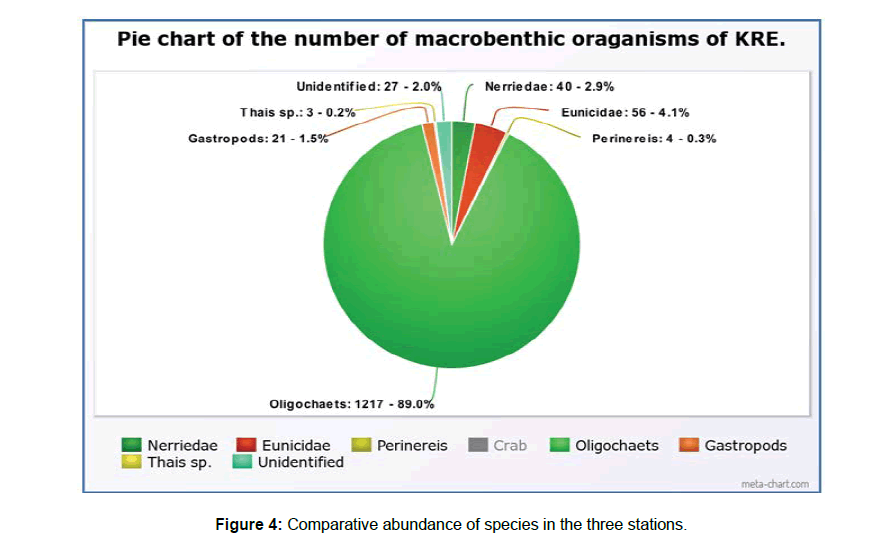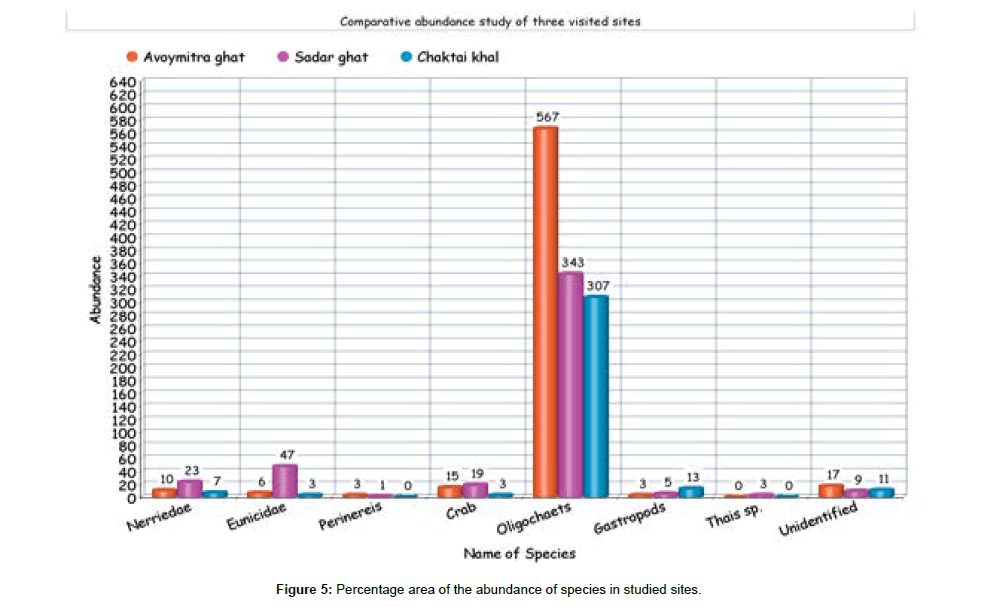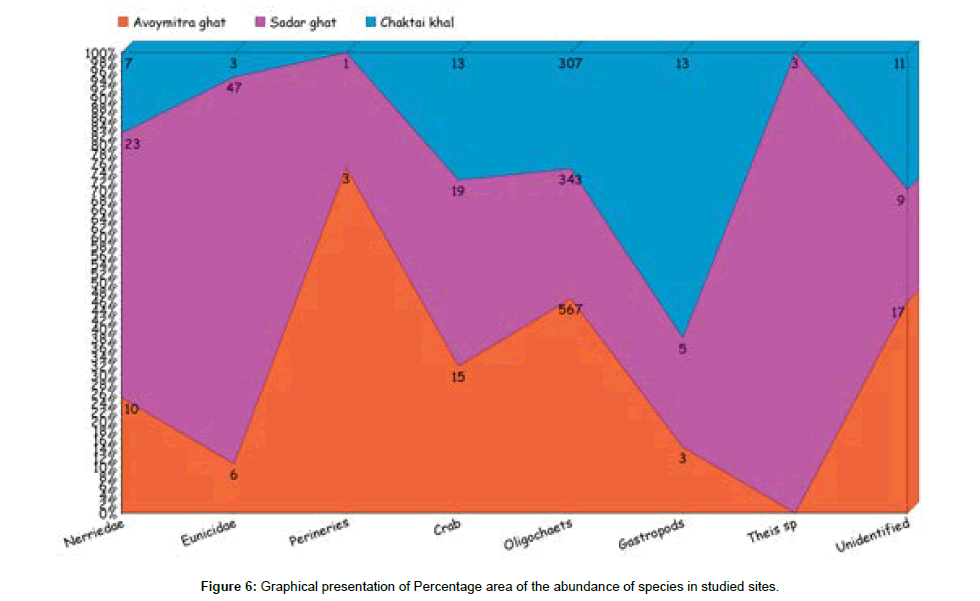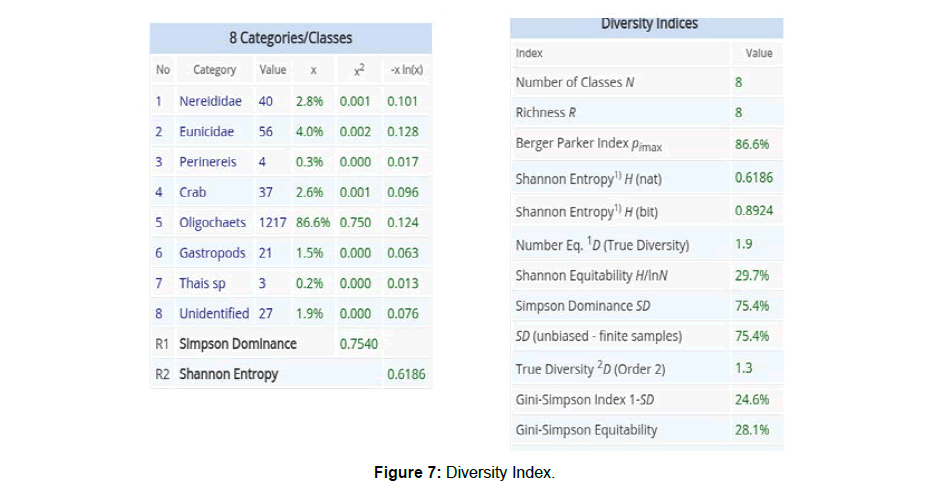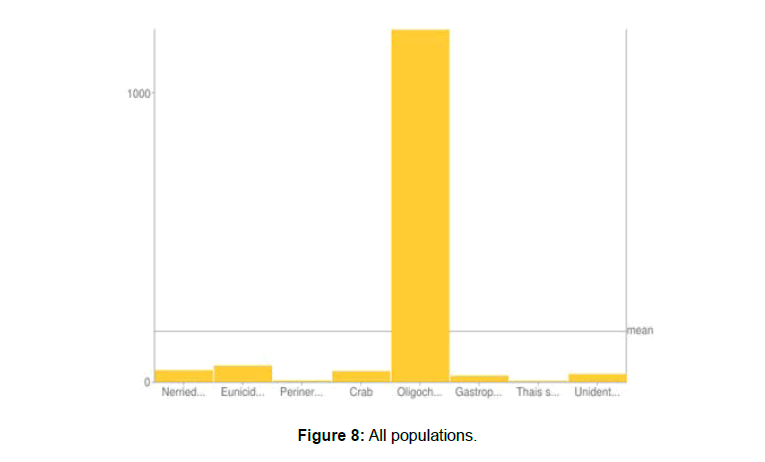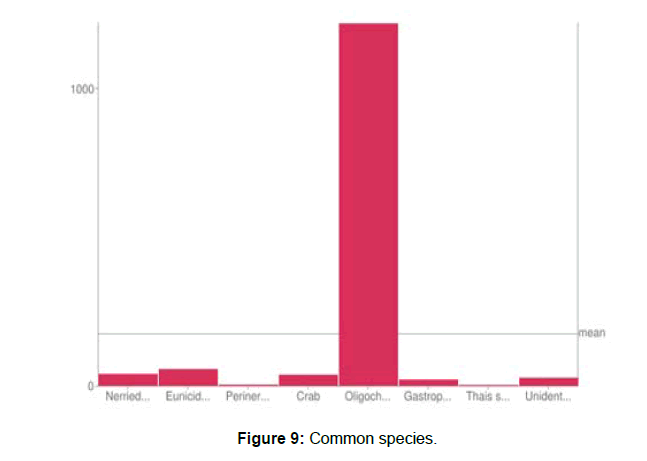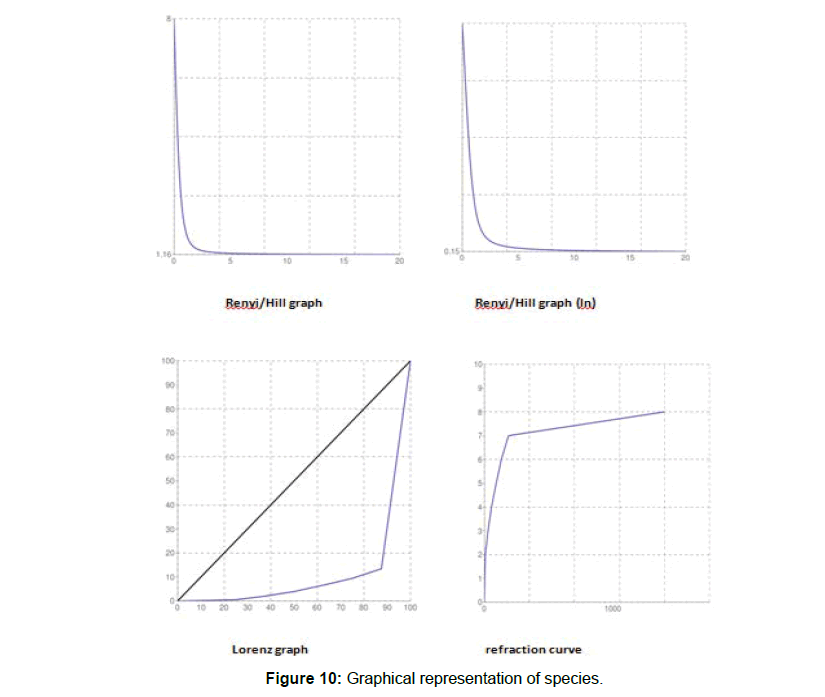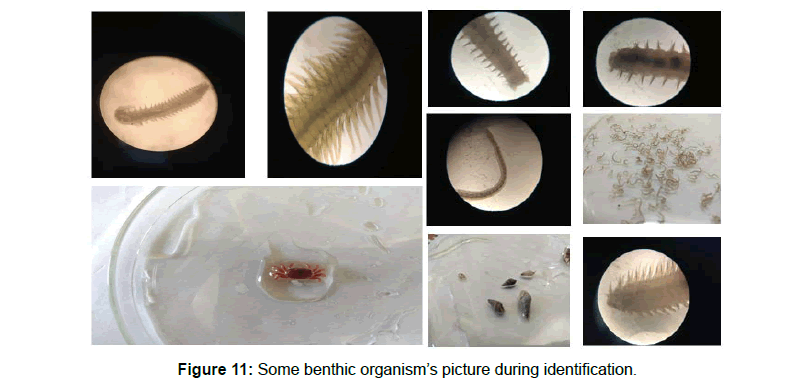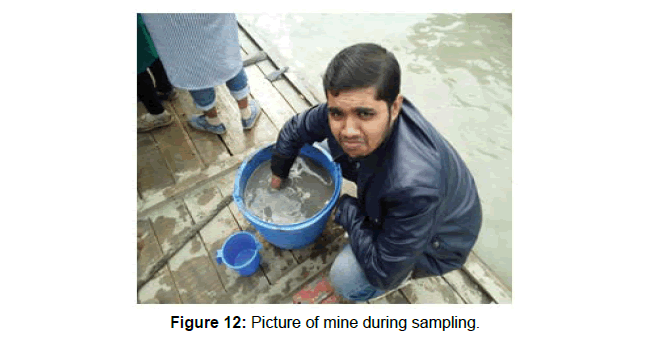Macrobenthic Organisms & Water Quality Assessment of karnafully River Estuary
DOI: 10.4172/2155-9910.1000305
Abstract
Benthos is the organism that inhabit in bottom of an aquatic body. Benthic organisms such as macro, meio and micro fauna and flora play an important role in food chains in an aquatic ecosystem. Macrobenthic organisms may be influenced positively or negatively by physico-chemical parameters of the environment depending on their sources. According to environmental conditions benthic communities vary considerably. The amount of nutrients released from the sediment by benthic communities may vary. Various physical and chemical conditions of the water body such as depth, current of the water, organic contents of the sediments, contaminations of bed sediments environment, toxicity of sediments influence the abundance and distribution of macrobenthos. Macrobenthos are the most commonly used organisms for bio-monitoring in lotic habitat worldwide. It is evident that macrobenthos play an important role in improving and preserving water quality through mineralization and recycling of organic matters.
Keywords: Benthos; Macrobenthic; Invertebrate; DO; BOD; Intertidal
Abstract
Benthos is the organism that inhabit in bottom of an aquatic body. Benthic organisms such as macro, meio and micro fauna and flora play an important role in food chains in an aquatic ecosystem. Macrobenthic organisms may be influenced positively or negatively by physico-chemical parameters of the environment depending on their sources. According to environmental conditions benthic communities vary considerably. The amount of nutrients released from the sediment by benthic communities may vary. Various physical and chemical conditions of the water body such as depth, current of the water, organic contents of the sediments, contaminations of bed sediments environment, toxicity of sediments influence the abundance and distribution of macrobenthos. Macrobenthos are the most commonly used organisms for bio-monitoring in lotic habitat worldwide. It is evident that macrobenthos play an important role in improving and preserving water quality through mineralization and recycling of organic matters. The physical and chemical status of the riverine ecosystem becomes recognizable through the elasticity of the community structure of the benthic organisms. That’s why benthic macro-invertebrates make ideal subject for biological assessment of water quality.
The community of benthic organisms is strongly affected by its environment, including sediment and water quality, and hydrological factors that influence the physical habitat. Because the macrobenthos are dependent on its surroundings, it serves as a biological indicator that reflects the overall condition of the aquatic environment. The variety and abundance of macrobenthos also vary with latitude, depth, water temperature, salinity, locally determined conditions such as the nature of the substrates, and ecological circumstances such as predation and competition. Physical, chemical and biological qualities of water are some of the factors that influence species composition, diversity, productivity and physiological conditions of local populations of a body of water. Macrobenthos are mostly found in the standing water body where the concentration of organic carbon higher than the others. Environmental condition is mostly responsible for the variation of benthos in different area those are substratum type, food availability and predation. Reported that one of the causes of global warming and ocean acidification is the rising of atmospheric carbon dioxide (CO2) which is considered as important drivers of change in biological systems. They are organisms serve as direct food for higher trophic organisms (e.g., fin and shell fishes) and act as ecological engineer recycling the organic matter and other debris. Soft bottom macro-benthos play an important role in aquatic community which is also involved in mineralization, promotion and mixing of sediments and flux of oxygen into sediments, cycling of organic matter and in effort to assess the quality of inland water. In addition, a number of benthic invertebrates, particularly clams, are consumed by humans and others, such as worms, are used for recreational purposes as fishing bait. Soft-bottom macrobenthos are used as the tools of bio assessment due to some special characteristics such as limited mobility, comparatively long life cycles and differential sensitivity to pollution of various kinds and they show the result of cultural eutrophication on aquatic environment quite satisfactorily. We gathered some information of macro benthic fauna from Sadarghat station, Avoymitroghat and Chaktai canal and also observed the biodiversity index and Water quality parameters from the 3 station, we visited.
Keywords
Benthos; Macrobenthic; Invertebrate; DO; BOD; Intertidal
Materials And Methods
Instruments
1) Mud corer
2) Sieve net (0.5mm)
3) Plastic bottles
4) Marker pens
5) Measuring cylinders
6) Formalin solution (10%)
7) Eosine
8) Plastic bottles
9) Measuring tape
10) Bucket
Study area and duration: Our studied stations were under Karnafully river estuary.
Site 01: Avoymitra Ghat
Site 02: Sadarghat
Site 03: Chaktai khal
Samples were collected from the three stations on 11th January, 2020.
Sampling design: 1 transects were created(1m×1m),And took 1 scoop of sediment from 1m^2, similarly 3 scoop were taken from 1 stations for finding exact diversity of organisms of that area.
Sample Collection and processing: Samples were collected by using a mud corer. The collected samples were washed through a 0.5 mm mesh hand sieve with filtered water at collection point to separate animals from the sediment. The materials retained on the sieve were taken in plastic vials and labelled, to which 70% alcohol were added for killing and fixing the organism.
Colorization: 3-4 drops of eosin was added to the sample for the colorization of the unidentified species [1].Qualitative analysis: Rose Bengal was added to the vials which help in sorting the organisms from debris. The materials were poured into a round transparent glass dish (diameter 15 cm and depth 2 cm) [14-17], magnifying glass and microscope were used in necessity. Then the organisms were preserved in 75% ethyl alcohol for identification and future record [18-21]. Identification was made to the lowest possible taxonomic level following the works of Gosner (1971) [7], Sterrer (1986), Ahmed (1990) [2], Rao et al. (1995) and Misra (1995) [3, 4]. Density measurement: Total count of specimens of the same groups was determined and the results were converted into number per square meter by unitary method [5] (Figure 1-3) (Table 1).
| Site | Location | Gps Location | Time | During | Sieve Net size | Sample Quantity | Formalin added |
|---|---|---|---|---|---|---|---|
| 1 | Avoymitraghat | 22.32403° N & 91.82938 E | 10.05 am | Low tide | 0.5 mm | 140 ml | 8 ml |
| 2 | Sadarghat | 22.32745°N 91.83901°E | 12.15 pm | High tide | 0.5 mm | 50 ml | 5 ml |
| 3 | Chakati canal | 22.3542°N & 91.8481 E | 2.55 pm | Low tide | 0.5 mm | 150 ml | 9 ml |
Table 1: We collected sample of benthos in Karnafully river estuary from the following points:-
Conclusion & Discussion
Nereididae, Eunicidae & Crab were found in most numbers in Sadarghat stations than the other stations, they are serially 23 ind/m^2,47 ind/m^2 and 19 ind/m^2.Oligochaets were mostly found in Avoymitra ghat,Gastropods were mostly found in Chaktai khal and its 13 ind/m^2.Thais sp were only found in Sadarghat. Unidentified species mostly found in Avoymitra Ghat and it was 17 ind/m^2.Comparing data it can be said that Sadarghat is more bio diversified area than the other sites. Oligochaets number indicates that Avoymitra Ghat is most polluted than the others. As, we didn't use Grab sampler, proper biodiversity determination was tough and polluted area indication was also very tough. But, our Monitoring says that Chaktai khal was most polluted than others.
References
- Alam MS (1993) Ecology of Intertidal Macro benthos of Halishar coast, Department of Zoology, University of Chittagong, Chittagong, Bangladesh, p.243.
- Ahmed ATA (1990) Molluscs of the Cox’s Bazar Area, BARC Final Report, Dhaka, Bangladesh ,p.133.
- Belaluzzaman AM (1995) Ecology of the intertidal macro benthic fauna in Cox’s Bazar Coastal area, Bangladesh. M.Sc Thesis, IMS, University of Chittagong, Bangladesh, p.199.
- Degraer S, Mouton I, De Neve L, Vincx M (1999) Community structure and intertidal zonation of the macrobenthos on a macrotidal, ultra-dissipative sandy beach: summer-winter comparison. Estuaries 22: 742-752.
- Devi LP, Natarajan P, Ammal GS, Azis PK Abdul (1996) Water quality and benthic fauna of the Kayamkulam backwaters and Arattupuzha coast along south west coast of India. Indian J Mar Sci 25: 264-267.
- Fernande RSR, Gomes AS (2006) Community structure of macro benthos in two tropical sandy beaches with different morph dynamic features, Rio de Janeiro, Brazil. Mar Ecol 27:160-169.
- Gosner KL (1971) Guide to Identification of Marine and Estuarine Invertebrates. John Willy & Sons Inc: p 693.
- Harakanta SN, Parulekar AH (1994) Independence of environmental parameters and sand dwelling benthic species abundance: A multivariate approach. Ind J Mar Sci 20: 232-234.
- Herman PM, Middelburg JJ, Van de Koppel J, Heip CHR (1999) Ecology of estuarine macro benthos. Adv Ecol Res 29: 195-240.
- McLusky DS (1989) The estuarine ecosystem. 2nd edn. Chapman and Hall, London, UK.
- Menge BA, Olson AM (1990) Role of scale and environmental factors in regulating of community structure. Trends Ecol Evol 5: 52-57.
- Misra A (1995) Polychaetes, Estuarine ecosystem series Parts 2. Hoogly Malta estuary: ZSI, India: pp 93-155.
- Rao SN, Dey BA, Barua S (1995) Molluscs, Estuarine ecosystem series Parts 2, Hoogly Malta estuary: ZSI, India: pp 41-91.
- Pratt HS (1935) A manual of the common invertebrate animals, exclu. AbeBooks Seller Inc: p 854.
- Ray GL (2004) Monitoring of intertidal benthos on the shoreline of Raritan and sandy hook bay, New Jersy, Interim Report. A report to the US Army Engineer District, New York. USA: p.41.
- Schoch GC (2001) The intertidal biota of Puget Sound Gravel Beaches. Report from the Washington State Department of Natural Resources Near shore Habitat Program: p 48.
- Sharif ASM (2002) A comparative study on Plankton and benthos of the Meghna River-estuary during monsoon and postmonsoon. MSc. Thesis, Institute of Marine Sciences, University of Chittagong, Chittagong, Bangladesh: p 125.
- Sterrer W (1986) Marine Fauna and Flora of Bermuda: A systematic Guide to the Identification of Marine Organisms. John wiley & Sons: p 742.
- Warwick RM, Clarke KR (1993) Increased variability as a symptom of stress in marine communities. J Exp Mar Bio 172: 215-226.
- Warwick RM, Goss-Custard JD, Kirby R, George CL, Pope ND, Rowden AA (1991) Static and dynamic environmental factors determining the community structure of estuarine macrobenthos in SW Britain: Why is the Severn estuary different? J. Appl. Ecol. 28: 329-345.
- Lutaenko KAA (2007). Preliminary review of species richness of the anadarine bivalves (Arcidae) in the Indo-West Pacific region. In: K.A. Lutaenko (Ed.). Biodiversity of the Marginal Seas of the Northwestern Pacific Ocean: Proceedings of the Workshop, Institute of Oceanology CAS, Qingdao, China, IOCAS, pp. 94-96.
Results
(Table 2) (Figure 4-9)
Table 2: Percentage of identified species in the three stations
Dissolved Oxygen (DO)
Take water sample in a BOD bottle but remember that as if there are no bubbles in BOD bottle taking water sample. Then the water sample has to be fixed with 1ml KI and 1ml MnSO4 and shaking the mixer [6]. After settling (10 min wait) then add 1ml H2SO4 (Conc.) and wait minimum 10 min up to maximum 2 hours. Then take 10ml from mixer in a conical flask. Now add 2-3 drops starch solution and turn into blackish. Now titrates it with Na2S2O3 (0.025N) [8]\, Just disappear the blackish point then stop Na2S2O3 from burette. After taking three times then make an average volume of Na2S2O3 [9-13] (Figure 10,11).
Table 3: Dissolved Oxygen (DO) and Bottle of Dissolved Solution
Table 4: Physico-Chemical parameters of collected water sample
Sequence of benthos according to the abundance in Karnafully River Estuary:
Oligochaets>Eunicidae>Nereididae>Crab>Gastropda>Perinereis >Thais sp.
DO (mg/l) = V × N × 5.6 × (1000/S) × B/ (B-A)
Here,
V = Volume of Na2S2O3
N = Normality of Na2S2O3 = 0.025
S = Sample of volume taking for titration = 10ml
B = BOD bottle volume
A = 2 (1ml KI + 1ml MnSO4)
Citation: Sajeeb MI (2021) Macrobenthic Organisms & Water Quality Assessment of karnafully River Estuary. J Marine Sci Res Dev 11: 305. DOI: 10.4172/2155-9910.1000305
Copyright: © 2021 Sajeeb MI. This is an open-access article distributed under the terms of the Creative Commons Attribution License, which permits unrestricted use, distribution, and reproduction in any medium, provided the original author and source are credited.
Select your language of interest to view the total content in your interested language
Share This Article
Recommended Journals
Open Access Journals
Article Tools
Article Usage
- Total views: 4293
- [From(publication date): 0-2021 - Dec 07, 2025]
- Breakdown by view type
- HTML page views: 3385
- PDF downloads: 908

